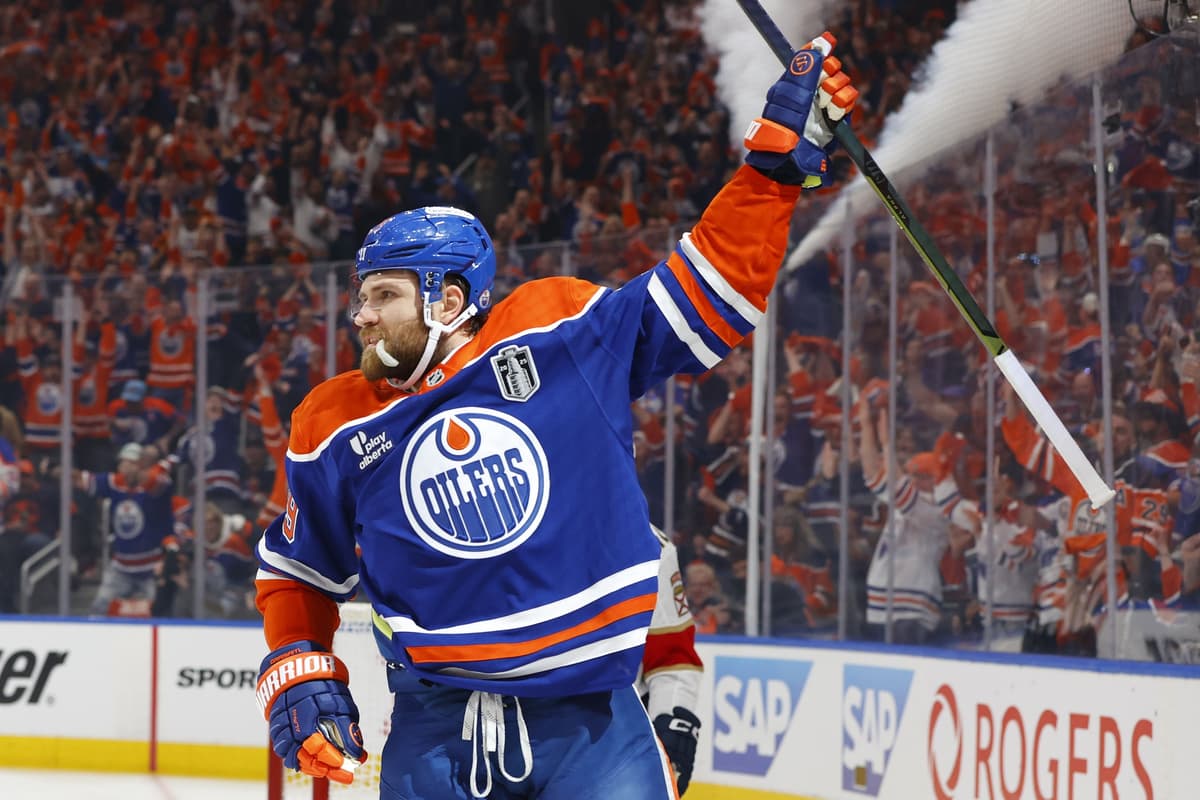Leon’s Night: How Draisaitl Stole the Spotlight, Made History for Germany, and Sent a Message to the Entire Hockey World at the 2025 ESPYS
Leon Draisaitl smiled the way only a player who has carried expectation for a decade can smile when recognition finally arrives on a stage built for the broader sports universe, not just the hockey diehards who have been arguing his greatness in late‑night forums for years. Under theater lights in Los Angeles, surrounded by quarterbacks, Olympic phenoms, tennis icons, and pop‑culture noise that rarely pauses for a face shield, the Edmonton Oilers superstar heard his name called as the Best NHL Player at the 2025 ESPYS—and the room did that quick double take reserved for athletes who have long deserved a mainstream coronation but somehow kept getting nudged behind flashier headlines. Make no mistake: this was not a courtesy nod; it was a recalibration. In a league where Connor McDavid’s physics‑defying brilliance has dominated highlight montages and where goaltending melodrama seems to trail the Oilers like jet wash, Draisaitl’s blend of raw production, situational lethality, and playoff hardness has too often been treated as an appendage to someone else’s legend. The ESPYS stage flipped that script, even if only for one evening, and in doing so poured accelerant onto a conversation that will shadow the rest of his prime: are we witnessing one of the most complete offensive forces of his era finally getting the wide‑angle lens he’s earned?
Awards shows are part performance, part politics, part numbers. Hockey’s culture generally shrugs at the red‑carpet pageantry, but the ESPYS hold unusual value because they extend beyond the sport’s borders and into the global sports bloodstream. When an NHL star wins here, casual fans—people who couldn’t diagram Edmonton’s power‑play umbrella if you paid them—suddenly ask, “Who is this guy, and why are hockey people obsessed with him?” That curiosity is leverage for the league; it’s also validation for players grinding through 82 games in frozen rinks while sharing shelf space with NFL playoff drives and NBA superteams. Draisaitl’s win carried an added layer: he is German, the most decorated German forward the NHL has ever seen, and every step he takes up a podium sends ripples through European development pipelines that still fight to keep kids in hockey when soccer and basketball siphon attention. On a night when television cameras panned across medalists and MVPs, the image of a Cologne‑born forward in an Oilers crest accepting a mainstream U.S. sports award became a recruiting poster for an entire continent.
Context strengthens the moment. Draisaitl didn’t simply ride residual fame. He earned the nomination on the back of another elite campaign in which he hovered near the top of league scoring, anchored one of the deadliest power plays ever assembled, logged heavy playoff usage, and repeatedly delivered under pressure when defensive game plans over‑committed to shutting down McDavid. Coaches will tell you the tape shows it: Draisaitl’s playmaking vision on the half‑wall, his ruthless one‑timer release from angles that most players would dust off and reset, his ability to shift from distributor to assassin depending on coverage. He creates passing seams where static penalty kills die, bullies zone entries by holding pucks an extra half beat until lanes open, and punishes lazy clears with quick pucks to the net that turn into scramble chaos. At even strength he toggles between center and wing reads with rare fluidity, a positional bilingualism that lets Edmonton reconfigure lines mid‑game without losing structure. These are connoisseur traits—not always viral highlight fodder, but the invisible engineering behind the Oilers’ scoring engine.
His postseason body of work continues to anchor his legacy. Say what you will about Edmonton’s heartbreaks; Draisaitl’s playoff scoring pace across recent springs has lived in rare air. He scores against structure, not just chaos—threading shots through layered shot blocks, curling into soft ice beneath collapsing coverage, hitting cross‑seam darts that drag goaltenders laterally into save‑selection nightmares. Opponents game‑plan him differently than McDavid; where 97 shreds you with speed and manipulative cutbacks, 29 suffocates you with weight shifts, deception, and release variance. Coaches would prefer to pick one poison; they get both. That two‑front elite threat is why Edmonton remains a perennial Cup conversation even when depth churn and goaltending volatility meddle with regular‑season lanes.
Draisaitl used his ESPYS mic time to thread thanks with quiet edge. He thanked teammates first—naming McDavid before anyone could bait a rivalry headline—and then pivoted to something that stuck: “Recognition is nice,” he said, “but in our room, banners matter more.” In a flash, he defused speculation that individual awards could fracture a superstar tandem while simultaneously re‑centering the only metric Edmonton cares about in the McDavid‑Draisaitl era: silver in June. That line traveled fast across hockey channels because it captured the paradox of elite athletes in team sports—collective ambition and individual greatness always in negotiation, never fully resolved.
Beyond the optics, Draisaitl’s win feeds the Oilers’ immediate competitive narrative. Edmonton entered the 2025 offseason juggling cap tension, roster attrition, and renewed scrutiny after losing more than sixty goals of depth scoring. Power‑play efficiency and top‑line production are no longer luxuries; they are structural requirements if the Oilers are to outpace Western rivals layering depth on depth. A national spotlight for Draisaitl helps in subtle cap‑politics ways: endorsement gravity rises, public valuation hardens, and internal contract chess recalibrates when a player’s global profile spikes. That can complicate negotiations—but it also energizes ownership to stretch where needed. Stars who move merchandise, ratings, and cross‑sport attention are economic engines. Edmonton’s front office understands this; Draisaitl’s ESPYS moment was a televised reminder of the external value they steward.
Germany’s hockey community erupted online as clips circulated. Youth coaches posted practice photos beside screenshots of Draisaitl raising the trophy; parents wrote about kids staying on skates another year; pundits noted the widening European footprint in NHL award spaces. International resonance may feel abstract on a July awards night, but it’s how the sport grows depth in future drafts. Edmonton, which once plucked a generational Canadian center and paired him with a German phenom, now sits at the nexus of hockey’s global interdependence. Every accolade Leon earns normalizes the idea that elite production can come from beyond the sport’s traditional North American or Scandinavian superhighways, encouraging scouts to widen nets and kids to dream in new languages.
What changes now for Draisaitl? On ice, probably nothing; his game has long since matured past the motivational peaks and valleys of trophies. Off ice, recognition breeds narrative obligations—national interviews, brand asks, increased scrutiny when icy spells hit. He’ll absorb that load the way he’s absorbed cross‑checks on the half‑wall: balance, push through, get back to work. The Oilers’ challenge will be insulating their room from award‑season static as training camp nears. Edmonton’s window remains unforgiving; McDavid’s prime is molten now, not theoretical later. The franchise cannot afford emotional drift into celebrity orbit. That’s why Draisaitl’s banner line mattered so much; he gave the fan base permission to celebrate while anchoring the mission.
Awards always spark debate—was McDavid robbed, did a goalie deserve it, what about playoff performance weighting? That noise is healthy; it means the sport still cares enough to argue. But sometimes debates obscure the thing itself: Leon Draisaitl has authored a run of production that would headline almost any franchise in the league were he not sharing ice with an era‑defining unicorn. The ESPYS vote, drawn from a broader sporting audience, cut through tribal arguments and simply said: we see you. For a player who has carried both brilliance and comparison, that matters.
In the hallway after the show, long after the broadcast feed rolled its last credits, Draisaitl reportedly tucked the trophy under his arm like a puck and joked with staff about making room in his luggage. That image—elite scorer, award in arm, thinking about logistics—felt right. It captured the vibe that has endeared him to teammates: practical, dry‑humored, aware that applause fades fast once skates hit ice. Edmonton will need that grounding when the season opens and every Western rival guns to test whether the Oilers replaced their lost offense, reinforced their crease, hardened their structure. Nights like the ESPYS don’t win playoff series, but they add fuel—the reminder that greatness here is visible to the world, that the stakes are worth the grind, that the story remains unwritten.
So remember the lights, the blue carpet, the cross‑sport cheers, the German flag emojis flooding timelines, the line about banners. Remember that hockey’s biggest stages sometimes appear far from frozen rinks, and that respect earned there can loop back and power a dressing room months later when bodies ache and series stretch. Leon Draisaitl owns that respect now in a way he never quite did before this summer. Whether the Oilers can translate it into the only hardware that matters in Edmonton will be the next great chapter. For one night, though, the crease drama, cap spreadsheets, and Western arms race faded, and the hockey world watched one of its most complete players claim center stage and smile like someone who knows the work still ahead is exactly why he plays.



